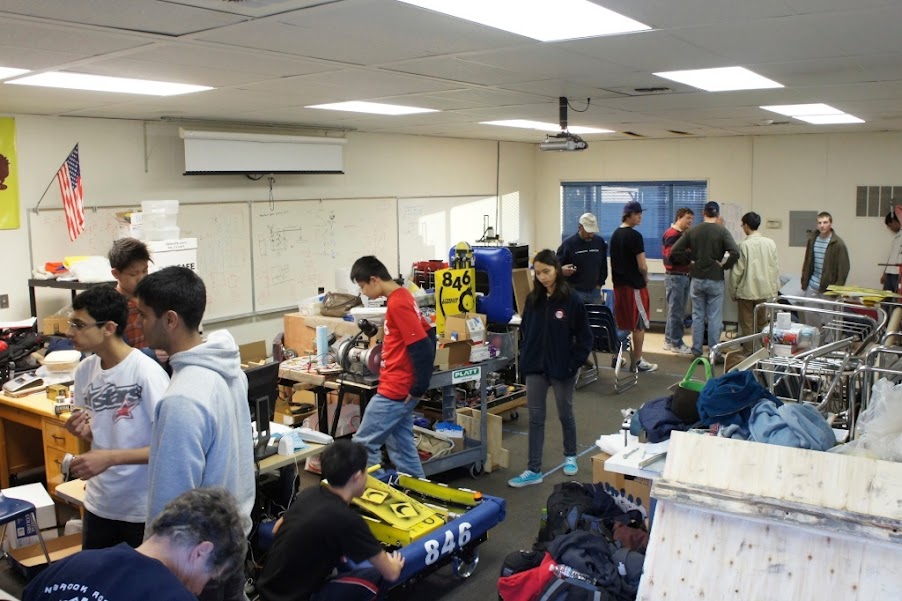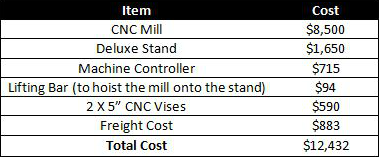About
Room 612
 Room 612 is our robotics workshop on Lynbrook High School's campus. For the first 10 years of our history, our team worked
out of various student's garages. Since we didn't have a permanent home, we would have to move all our equipment to a
new garage every season. This all changed in 2011 when the Fremont Union High School District and Lynbrook's administration
generously decided to give us Room 612, a portable classroom on the edge of campus. This additional space allowed us
to outfit the room with new machinery which wouldn't have been possible in our previous situation. We are proud call
Room 612 the home of the Funky Monkeys!
Room 612 is our robotics workshop on Lynbrook High School's campus. For the first 10 years of our history, our team worked
out of various student's garages. Since we didn't have a permanent home, we would have to move all our equipment to a
new garage every season. This all changed in 2011 when the Fremont Union High School District and Lynbrook's administration
generously decided to give us Room 612, a portable classroom on the edge of campus. This additional space allowed us
to outfit the room with new machinery which wouldn't have been possible in our previous situation. We are proud call
Room 612 the home of the Funky Monkeys!
Machines
Tormach PCNC1100
The CNC mill was recently purchased and first used for the 2012 build season. Previously, our team would need to travel to
nearby machine shops to fabricate many of our parts, but when this CNC mill was successfully set up in Room 612, everything
changed.
 Even during off season, our team still uses this CNC mill regularly to machine parts to incredible tolerances.
Even during off season, our team still uses this CNC mill regularly to machine parts to incredible tolerances.
Specifications :
Travel: 18" x 9.5" x 16.25" (X,Y,Z)
Spindle: 100 - 5140 RPM, 1.5 HP
Feed Speed: 110 IPM (X,Y), 90 IPM (Z)
Power: 230 VAC, Single Phase
Weight: ~1600 lbs (with deluxe machine stand)

Our Experience:
After we saved up to buy this amazing machine, one of the biggest challenges we faced was just getting it into our room! We knew from Tormach's CAD drawings that the CNC mill would barely fit through our workshop's front door. After a few hours of careful maneuvering and the removal of the Y-axis stepper motor, we finally were able to squeeze the machine through the door. Once we were inside the room we still had to deal with another issue. Because the mill weighs close to 1300 lbs without the stand, we were very concerned if our portable classroom's floor would be able to handle the load. To prevent our CNC mill from falling through the floor, instead of moving the mill across the room on wheels, we took inspiration from the Egyptians and used several steel tubes to roll the machine inch by inch across the workshop floor. We also decided to coat the floor in plywood to help spread out the weight of the mill. Once in place, using an engine hoist, we lifted the mill into the air and set it on top of our stand. At it's final resting point, set-up was a breeze! Tormach's directions were easy to follow and it only took a couple student about a day's work to complete the task.

Although this mill is rather small in comparison to its commercial counterparts, it is quite capable. We ordered our machine with the "Deluxe Stand" option, meaning our machine comes flood coolant equipped. The flood coolant system helps cool the tool down as it cuts, this prolongs tool life. The system also lubricates the cutting surface which helps achieve a beautiful, smooth finish. This paired with its powerful spindle, relatively fast feed rate, and reasonably large travel make this a very capable machine.

The CNC mill uses a machine control called "Mach3". This software interprets G-code and translates them into movements on the CNC mill. Mach3 also comes with several handy "Wizards" which allow users to quickly create tool paths for simple features for things like holes, bolt patterns, and lightning holes without using CAM software. Of course, as a robotics team, we had the need to make more complex parts that the Mach3's "Wizards" couldn't handle, for this we needed to purchase a dedicated CAM tool. CAM software is designed take a solid body, created in a CAD tool such as Autodesk Inventor or SolidWorks, and translate it into a series of G-code instructions that the CNC mill can follow. To do the job, we chose to buy an education copy of a professional level CAM tool called "GibbsCAM". While many CAM tools have high learning curves, once they are mastered, you can use your CNC mill to make some really amazing parts!
While learning the quirks of our CNC mill was slow going at first, we have been steadily making progress. By the end of the 2012 build season, we were finally beginning to feel confident using our mill. In retrospect, we feel that the CNC mill was a great investment, and it will be an invaluable asset in the future. We love our CNC mill!
Mini-Mill
 Even though the mini mill is by no means a CNC mill, it is still loved. Using rotating knobs, you can manipulate the
table in all three axis (X, Y, and Z) this awesome tool enables us to complete simple milling and drilling operations.
Because the CNC mill becomes very busy during build season, the mini mill is usually used to perform simple tasks such
as cutting lightning holes, facing, etc.
Even though the mini mill is by no means a CNC mill, it is still loved. Using rotating knobs, you can manipulate the
table in all three axis (X, Y, and Z) this awesome tool enables us to complete simple milling and drilling operations.
Because the CNC mill becomes very busy during build season, the mini mill is usually used to perform simple tasks such
as cutting lightning holes, facing, etc.
Mini-Lathe
 A lathe is used to cut parts with symmetry over their rotational axis. Several operations can be performed on a lathe
some include facing, drilling, boring, parting, turning, and knurling. We often use our lathe to cut slots for retraining
clips, it also comes in handy for cutting precision spacers!
A lathe is used to cut parts with symmetry over their rotational axis. Several operations can be performed on a lathe
some include facing, drilling, boring, parting, turning, and knurling. We often use our lathe to cut slots for retraining
clips, it also comes in handy for cutting precision spacers!
Lathe
Similar to the mini-lathe but much bigger, this monster is competing with our PCNC for the title of the biggest, baddest and noisiest machine in the shop. Equipped with a digital readout displaying the coordinates of the cutting tool, the lathe can be used to cut parts with precision down to a few thousandths. The precise capabilities of our lathe can be used to not only churn out precision spacers and plugs but also make complex modifications to motor and gearbox shafts, turn out large standoffs and much more. The lathe and the CNC have been equipped with pneumatic hoses to blast your part with air, blowing away all those cool chips that a lathe produces and sometimes providing a clean alternative to oil.



